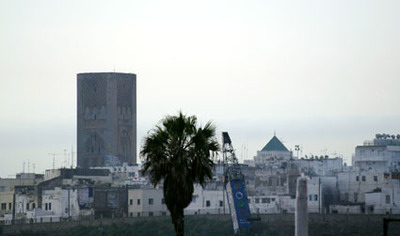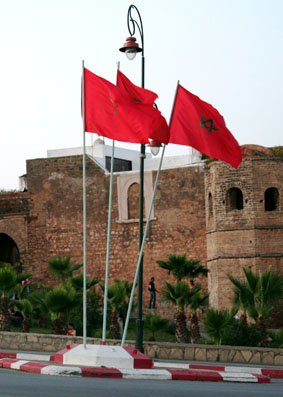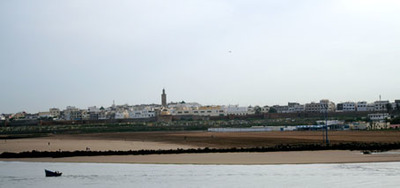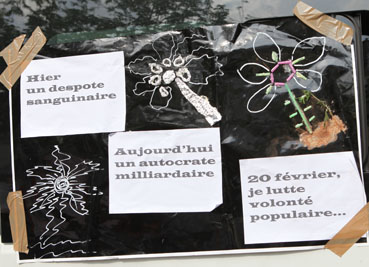I have just returned from an inspiring trip to Rabat and Marrakech,
where the massive, peaceful, demonstrations of the February 20th
Movement (the Moroccan incarnation of the Arab Spring) has opened up a
space of relative freedom for people to breathe free, demonstrate
their greviences and discuss their ideas in print and in public. It is
an exciting place to be, where every day new groups are getting
organized and putting forward their grievances. During my two weeks in
the country, I saw demonstrations — long banned under an oppressive
police-state — nearly every time I went out for the day. One day I
came upon a large group of men dressed all in white carrying banners
and chanting (in Arabic of course). By their garb, they appeared to me
to be members of some Moslem sect I had not yet encounter, Sufis
perhaps? But when I got up close, I saw they were medical personnel,
mostly public health doctors, dressed in surgical garb, demonstrating
for better pay and more funding for their clinics.
You don’t read much about the ongoing struggle for democracy in
Morocco, mainly I suppose because of the lack of violence. Of course
the terrorist bomb attack on the main square of Marrakech, which I
missed by a day, did make headlines. In Morocco it was feared that the
tragedy would be used to clamp down on the movement (and rumoured that elements of the DST secret police may have been involved), but King
Mohammed VI remained calm, and the comrades of February 20th Movement organized a hugely successful mass demonstration in Marrakech against terrorism at the site of the bombing, proclaiming their democratic and non-violent goals.
The Monarchy
Morocco is an authoritarian monarchy, and although it has a
parliament, His Highness Mohammed VI holds a monopoly of temporal and
(as Commander of the Faithful) spiritual power. Descended both from a
long line of Sultans and from the Prophet Himself, the Monarch’s
person is sacred. Only yesterday, May 23, was taboo on the Monarch’s
sacred person broken for the first time when a demonstration of
unemployed youth greeted the Mohammed VI, on his daily public
appearance after saying noonday prayers, with their protests and
demands. The Moroccan Monarchy also has an aureole of political
legitimacy as the incarnation of the nation. At the end of WWII,
Sultan Mohammed V raised the cause of independence from the French.
The French Protectorate replaced him with a rival and exiled him to
Madagascar, but he eventually came to power on the force of a mass
movement (‘The Revolution of the King and the People’), and ruled with
the participation of progressives, including the outstanding
revolutionies like the Jewish Trotskyist engineer Abraham Serfaty and
the popular radical Left nationalist Ahmed ben Barka.
In 1961 Mohammed V was succeeded by his son, Hassan II, an
authoritarian monster whose power base was in the traditional
reactionary landowning classes. Hassan II threw Serfaty in jail, had
him tortured, and left him there to rot. Ben Barka was kidnapped in
Paris with the complicity of the French secret police and turned over
to Hassan II who had him tortured to death. Hassan II’s reign of
terror — supported by the CIA, Israel, and the French DST — lasted 40
years, although in 1991 he did let up, released some prisoners, and
allowed some exiles to return. He died in 1999, leaving the country in
the hands of the Mahkzen — an occult nexus of Palace officials, Army
officers, the DST (political police), wealthy magnates, local
chieftains and their clients — who monopolise the levers of power at
every level.
Hassan II’s successor, the youthful Mohammed VI, seems a decent sort
and may have aspired to imitate Juan Carlos I, the Spanish Crown
Prince who liberalized his country as soon as Franco died. He even
went so far, in 2006, as to officially decree the equality of women in
Morocco. But the all-powerful social and political structure of the
Mahkzen remains in power, with a charade of alternating parties in a
sham parliament and few civil liberties, and the equality of women,
like other reforms, has not been enforced. Meanwhile, social
inequality keeps increasing, while the government spends billions on
building a totally unnecessary luxury high-speed TGV train from
Tangiers to Agadir when what is needed are roads, clinics, schools and
jobs.
The Monarchy’s response to the Arab Spring has been extremely
judicious. When the demonstrations spread across the country on
February 20, the government recognized the demand for redress of
grievances and did not resort to slander or harsh repression like the
despots in other Arab countries. (On the other hand, the next day the
police quietly and selectively beat up on demonstrations and meetings
that were continuing the movement.) Rapidly, on March 9, Mohammed VI
took back the initiative with a major speech in which he raised the
minimum wage by 15% (over two years), increased scholarships for
students, raised the pay of civil servants including the Army, called
for a parliamentary commission to revise the Constitution and set June
24 as the date for a referendum.
His Majesty also, in the name of Human Rights (and I suppose in his
role as Commander of the Faithful), pardoned a large number of
heretics — Islamic Fundamentalists (or ‘Salifists’ as they are called
in Morocco) who had been arrested en masse after a horrible terrorist
bombing in Casablanca in 2005 and left to rot in jail by the
thousands. Curiously, many of these revenants sheiks have, on their
release, acknowledged the role of the February 20 movement in their
release, and some have agreed to abide by its principles of secular
democracy, human rights and female equality. Indeed, the Islamist Al
Adl Wal movement, descended from Suffi Fundamentalist Shiek Yassine,
provides the February 20 movement with much of its strength and
respects its discipline. (There is also a loyalist official moderate
Islamist party represented in Parliament which does not support the
February 20 Movement, and reactionary Salafists who try to take over
protests).
The February 20 Movement
Meanwhile, the spontaneous February 20 Movement had been moving ahead, getting organized on line and on the ground, pushing forward the
boundaries of protest, bringing together a coalition, and somehow,
using Facebook, developing its ten-point program.This young Movement,
which started among young students on Facebook and road the wave of
massive demonstrations sweeping the Arab world, owes its unity to this
excellent ten-point program which all its adherents — including
Marxists, Islamists, Human Rights fighters, etc — must observe. So
the movement is very broad and heterodox, but united in action.
It’s a kind of SDS-style do-it-yourself movement, and mostly things
get organized via text-messages, cell-phones and the like. February 20
has so far been able to keep up the strength of its demonstrations,
and is now moving towards deepening its roots in the community and
countryside. There are General Assemblies in every locality and the
young activists stay up late arguing principles and trying to find
consensus. (Everybody gets to talk. It takes time). There are also
great on-line newspapers in Arabic and French, like Ali Lmrabet’s
DEMAIN, now back in business.
http://www.emarrakech.info/Demain-on-line_a55316.html and discussion
sites like http://www.mamfakinch.com/ (where I occasionally post). And
credit should go to Al Jazeera (which you can get in English on line
and via satellite) for propagating the revolutionary seeds of the Arab
Spring by its, to my mind, totally professional and un-biased coverage
(check out the Al Jazeera Washington bureau for balanced and objective
US news!)
May Day in Rabat
I did get to participate in the May Day demonstration in Morocco, as I
had hoped in my previous article, but it was somewhat of a let down.
Partly because it was cold and rainy in Rabat and I had arrived with
tropical-type clothes and got totally chilled. But mainly because I
discovered that the Moroccan trade-union movement is so deeply
divided, that there were four separate May Day parades — despite
efforts to unite. Two of the federations are openly allied with the
government, and the February 20 people divided their marchers between
the two other, more progressive groups. Moreover, turnout was poor as
the majority of unionised workers, disappointed with their leadership,
stayed at home. Clearly, the spreading Egyptian movement of
self-organised unions has not yet reached Morocco. On the other hand,
it was a thrill to march with February 20th contingent, with young and
old, workers and students, women in headscarves and bare-armed,
bare-headed co-eds in Hippie-style garb shouting out the slogans from
the back of a slow-moving truck. Curiously, the ‘nastiest’ slogans
(mentioning by name actual corrupt officials) came from the Islamist
ranks.
A few days later, I had the opportunity to give a talk at the
Benslimane section of the Moroccan Human Rights Association (my French
translated into Arabic!). Of course whenever I talk with Arab comrades
(we have a Committee to defend the Arab revolutions here in
Montpellier, where there are 40,000 Moroccans living) I like to tell
them about the Wisconsin Effect and how delightfully ironic it is that
’The Arabs are teaching us Americans about democracy!’ It’s a great
ice-breaker and sets up the next point: we’re all together fighting
back against the international neo-liberal reactionary capitalist
offensive. (They videoed the meeting, and I hope it will be on U-Tube
soon).
My talk was held in the Benslimane ’House of Books,’ and the occasion
was a book-launch for the Arabic publication of Raya Dunayevskaya’s
MARXISM AND FREEDOM, which was sponsored by the Victor Serge
Foundation (which paid for the translation) and introduced by Maâti
Monjib and myself. I am pleased to say we sold 38 copies at the
meeting and that of the whole edition of 3000 copies, only 400 were
returned — which is pretty amazing in Moroccan publishing. Maâti says
that in Morocco they count five readers for every book, which means
more than 12, 000 Moroccans may soon have read this Marxist-humanist
classic. It couldn’t have come at a better time. I’ve asked a couple
of comrades to review it in Arabic, and we are hoping to have the
Arabic text available on line soon, as well as to promote editions in
Egypt and/or Lebanon if possible. (Any leads?) The Arab Spring has
proven once again that revolution from below is possible: the crucial
question is ‘What happens after?’ and books like Dunayevskaya’s (and
Serge’s, which are next to be translated into Arabic) are needed to
fill the theoretical void, which will otherwise be filled by harmful
ideologies.
Indeed, the assigned subject, ’Human Rights and Left Ideologies,’ gave
me the opportunity to dismiss ALL ideologies — free market, Islamist,
totalitarian communist, nationalist etc. — as forms of false
consciousness rationalising the power of one or another ruling class.
All these ideologies are oppressive; what is needed is a PHILOSOPHY of
Freedom.
Women as Subject
As for the ’human rights’ part of the topic, I took as my text Hegel’s
Master/Slave dialectic, where the Master knows only his privilege and
arbitrary will, while the slave, revolting against her oppression,
discovers a mind of her own. This went over very well with my
audience, half of whom were women wearing head scarves. Especially
when I used ’husband’ and ’brother’ along with ’Pharaoh’ as examples
of the Master. (I could hear Raya’s cackling laugh when that one went
over). So human rights became a question of Subject, of womens’ revolt
and self-activity, rather than an object, something handed down by the
UN.
I also tried to make the point that the best way to overcome the
influence of Salafism (reactionary Islamism) is NOT to polemicize
(which would be accepting the opponent’s GROUND for debate) but to
undermine Salafism by insisting on women’s equality, women’s rights.
As the women in headscarves lined up for me to sign their copies
(I guess as Prefacer) of Raya’s book in Arabic, I wished I could speak
Arabic and had had more time to talk with them individually. One thing
I learned, however, is that in Morocco what a woman puts on her head
doesn’t necessarily tell you what’s going on IN her head.
It is increasingly clear that women’s’ rights are central to the
developing social revolution in the Arab world, and the
revolutionaries of the February 20th Movement I met in Rabat and
Marrakech all seemed very much aware of this priority. For them, it is
no longer a question of solving the ’women question’ AFTER the
revolution, but of putting it first, at the cutting edge of the
struggle. ’Women as vanguard’ if you will. (This is also the line of
the senior leaders of La Voie démocratique, the historic Marxist (more
or less Trotskyist) party in Morocco, with whom I spoke.) This is
certainly a big step forward. So is the recognition of mass creativity
FROM BELOW on the part of these old Marxist fighters (many of whom
endured prison and torture during the ‘years of lead’ under Hassan II)
as they move forward to incorporate a new generation, deepen their
roots by eliciting the grievances of the people and helping them
organize during this period of tentative freedom.
Non-Violence and Internationalism
Another wonderful aspect of this amazing Arab Spring is the
generalized reliance on non-violence, which is proving more and more
effective even in countries like Syria and Yemen, where women have
continued to play a major role despite the violence of the
governments’ crackdown and the traditions of a gun-toting tribal
society. It is wonderful to see the U.S. media stereotype of the
Violent Arab Maniac exploded by this historic outpouring of
self-disciplined mass non-violent struggle across a whole region. Much
has been made (for example by the N.Y. Times) of the contribution of
foreign non-violent strategists like Vermont Professor Gene Clark, but
it turns out that the Islamic world had it’s own historic non-violent
role-model in Khan Abdul Ghaffar Khan, the ‘frontier Ghandi,’ who
according to Michael Shank (the Nation March 16) ‘built a 100,000
strong non-violent resistance movement out of local tribal people’
among the Pashtouns on the Pakistani-Afghanistan border – an arbitrary
frontier imposed by the British the better to divide and rule the
Pashtouns. According to Khan, ‘Mohammed taught that a Moslem is one
who never hurts anyone by word or deed.’ The record of British
atrocities against Khan’s peaceful followers in the ‘20s was worthy of
a Kadaffi. So much for the Clash of Civilizations.
The strength of the burgeoning democratic and social revolution in
Morocco continues to depend in part on the strength of the ongoing
international movement known as the Arab Spring. It would be wonderful
if the Moroccan movement, having carved out a space of relative
freedom in a stable land, could share it with activists from movements
in the other Arab lands by hosting some kind of pan-Arab Spring
Encounter where they could talk freely among themselves and begin to
organize this powerful international revolution which up to now has
mainly known itself ‘virtually,’ through the media and the Internet.
The feeling of hospitality is strong in Arab culture, and one hopes
that the Moroccan revolutionaries might think of paying their debt of
solidarity to the Arab Spring by opening its harbor of peace (dar es
Salaam) to comrades from other nations. This is a project I hope to
see developing. Inch-Allah!








